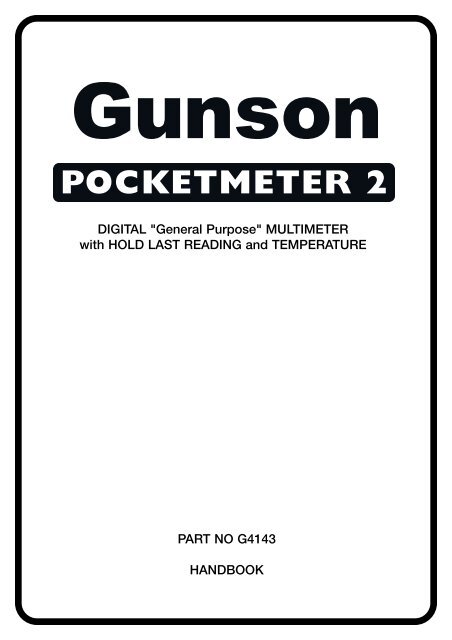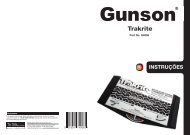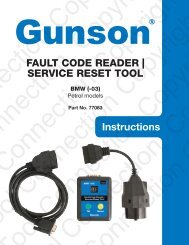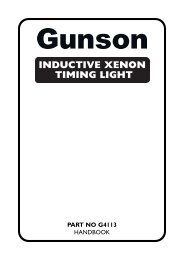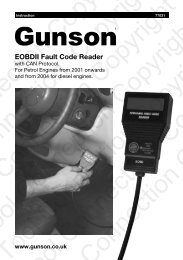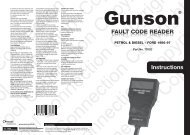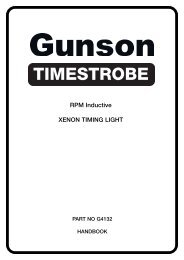POCKETMETER 2 - Gunson
POCKETMETER 2 - Gunson
POCKETMETER 2 - Gunson
You also want an ePaper? Increase the reach of your titles
YUMPU automatically turns print PDFs into web optimized ePapers that Google loves.
<strong>POCKETMETER</strong> 2<br />
DIGITAL "General Purpose" MULTIMETER<br />
with HOLD LAST READING and TEMPERATURE<br />
PART NO G4143<br />
HANDBOOK
<strong>Gunson</strong> Timestrobe<br />
<strong>POCKETMETER</strong> 2<br />
DIGITAL "General Purpose" MULTIMETER<br />
with HOLD LAST READING and TEMPERATURE<br />
INDEX<br />
Page<br />
1 INTRODUCTION 2<br />
2 DESCRIPTION 3<br />
3 PRECAUTIONS 4<br />
4 VOLTAGE 5<br />
5 CURRENT 7<br />
6 RESISTANCE 8<br />
7 CONTINUITY TEST 8<br />
8 DIODE TEST 9<br />
9 TRANSISTOR TESTING FACILITY 9<br />
10 THERMOMETER FACILITY (where applicable). 10<br />
11 CIRCUIT PROTECTION 10<br />
12 SPECIFICATION 11<br />
13 WARRANTY 12<br />
The 10 Amp circuit of this meter is un-fused.<br />
Overloading will cause serious damage and invalidate the warranty<br />
1
<strong>Gunson</strong> Timestrobe<br />
1. INTRODUCTION<br />
Pocketmeter2 is a pocket size multimeter which can be used for many applications around the<br />
home and in motor vehicle maintenance.<br />
The massive growth in popularity of electrical and electronic equipment over recent years has<br />
created a requirement for test devices. These have also advanced considerably in the range of<br />
facilities offered and of relatively low complexity and correspondingly low cost.<br />
This handbook assumes that the user has a reasonable understanding of basic electrical terms<br />
VOLTS, AMPS and OHMS, and how these units are related. Without this basic understanding of<br />
the fundamentals of electrics, a user will have difficulty in interpreting the measurements.<br />
Similarly the user should have some knowledge of the equipment being serviced/repaired in<br />
order to use this product effectively.<br />
<strong>Gunson</strong> can accept no responsibility for incorrect diagnosis of faults, or consequential damage<br />
occasioned by the use of this product. A helpline exists for technical enquiries regarding<br />
<strong>Gunson</strong> products<br />
Tel: 01926 818181<br />
This equipment bears the CE mark indicating that it complies with European Low Voltage<br />
Directives including Electro Magnetic Compatibility. This ensures that the equipment does not<br />
emit excessive interference and is not adversely affected by interference of a level defined by the<br />
regulations.<br />
However some circuits e.g. Brush motors, Spark ignition systems, may generate excessive electrical<br />
noise and / or emit high levels of interference. Levels will generally be at their greatest,<br />
very close to the circuit and will also be increased by poor connections or faulty components.<br />
Intense interference may effect test equipment together with other electrical items such as radio<br />
or television receivers, computers etc. Interference is likely to be increased just by making electrical<br />
connections to the circuit and the user is therefore advised that testing should be undertaken<br />
with due care and not in an area close to sensitive electronic equipment.<br />
The user should ensure that the meter is being used according to the instructions and that a reasonable<br />
measurement is being attempted. If the display behaves in an erratic nature either a<br />
rapidly fluctuating signal is being measured or excessive interference is present.<br />
The user is advised to read the safety precautions on Pages 4 and 5 before commencing<br />
work.<br />
2
<strong>Gunson</strong> Timestrobe<br />
2. DESCRIPTION<br />
(a) DISPLAY<br />
Pocketmeter2 has a Liquid Crystal Display (LCD), showing 32 digits (ie maximum scale reading<br />
1999, minimum scale reading -1999). Over-range is indicated by 1, and zero by 000. The battery<br />
symbol is illuminated when the internal battery of Pocketmeter needs replacing.<br />
(b) FUNCTION SWITCH<br />
This is used to select the appropriate function. Ensure that the switch is restored to the "OFF"<br />
position after use. In the OFF position, no current is drawn from the battery, which preserves the<br />
life of the battery.<br />
In the centre of this switch is a button, which if pressed once, retains the present reading in “<br />
HOLD” until it is pressed a second time, when the display reverts to its normal changing appearance.<br />
(c) LEADS AND PROBES<br />
Two Leads are provided, each fitted with Red or Black Probes and a Temperature Probe (details<br />
of how to use this are give in Section 10).<br />
In use, the BLACK LEAD is always connected to the bottom socket marked "COM" (which is an<br />
abbreviation of COMMON).<br />
The RED LEAD is connected to the middle socket (marked "V ø mA or V ø mA °C ") for all<br />
ranges except 0 - 10 Amps.<br />
For 0 - 10 Amps only the RED LEAD is connected to the far left-hand socket.<br />
The probes must always be removed from the circuit being tested if the case is to be<br />
opened, e.g. for changing the battery or fuse.<br />
(d)<br />
BATTERY<br />
9 VOLT, type PP3 or equivalent. If the meter is not to be used for a lengthy period, or if the battery<br />
is not in good condition it should be removed to avoid damage by leakage of battery fluids.<br />
The battery symbol or "BATT" appears in the display, when the battery voltage has fallen to<br />
approximately 7.5 volts.<br />
To fit or replace the battery, remove the 2 screws, under the small rubber feet and carefully take<br />
off the back of the case). The battery and fuse compartment are then exposed. Fit the battery<br />
using the snap connector. Refit the back carefully and do not over-tighten the screws.<br />
(e)<br />
FUSE<br />
The fuse is only used during current measurement on the 0 - 200 mA range. On other ranges,<br />
Pocketmeter may be used with no fuse fitted. To replace the fuse, remove the back of the instrument<br />
as described above. Use only high quality fuses rated at 500mA. To test a fuse, use the<br />
CONTINUITY test.<br />
The 0 - 10 Amp range is not protected by a fuse. Care must be taken to avoid damage to the<br />
instrument. Such damage is not covered by the warranty.<br />
3
<strong>Gunson</strong> Timestrobe<br />
3. SAFETY PRECAUTIONS<br />
While working with electrical measurement & test equipment be aware that:<br />
Testing of household and work-place electrical supplies is hazardous and should be undertaken<br />
only by an experienced or qualified electrician. Ensure that you have sufficient understanding of<br />
any equipment you are servicing as well as the equipment you are using. Even low voltage<br />
equipment can generate high voltages internally using transformers and electronic circuits.<br />
Electrical supplies over 40 Volts are potentially hazardous as are all supplies which are capable<br />
of delivering a high current. High voltage produces a risk of electric shock and high current in a<br />
conductor or component produces risk to eyesight as well as the risk of burns. Circuit breakers<br />
and fuses only offer limited protection. Use approved eye protection where appropriate.<br />
Where appropriate seek advice and follow the guidance of a suitable publication.<br />
Keep children, pets and others who do not appreciate the hazards well away from the work area.<br />
While working on a vehicle be aware that:<br />
Testing of vehicles is potentially hazardous. Take every precaution to avoid injury and ensure<br />
that you have sufficient understanding of the task being undertaken. Seek advice or follow the<br />
guidance of a comprehensive vehicle manual. Always follow vehicle manufacturer's warnings,<br />
cautions and service procedures.<br />
Using this product can involve working on a car while the engine is running. This is a potential<br />
hazard and the user should take every precaution to avoid any possibility of damage or injury.<br />
Never wear loose clothing that can catch in moving engine parts and always tie-up or cover long<br />
hair. Do as much of the work as possible with the engine not running.<br />
Always operate the vehicle in a well ventilated area. Do not inhale exhaust gases - they are very<br />
poisonous. Always make sure the vehicle is in park (Automatic transmission) or neutral (manual<br />
transmission) and that the parking brake is firmly set.<br />
Always keep yourself, tools and test equipment away from all moving or hot engine parts,<br />
remember that thermostatically controlled fans may suddenly start with no warning. Treat high<br />
tension ignition components with respect, remembering that electrical shocks can cause involuntary<br />
movement which may result in secondary injury.<br />
Never lay tools on a vehicle battery. You may short the terminals together causing harm to yourself,<br />
the tools or the battery. When carrying out tests on a motor vehicle, remember that you<br />
should NEVER run the engine with the car battery disconnected (either + or -) since the alternator<br />
would then run at a damaging over-voltage.<br />
Never smoke or have open flames near the vehicle. Vapours from gasoline and a charging battery<br />
are highly flammable and explosive. Always keep a suitable fire extinguisher handy.<br />
Always turn ignition key OFF when connecting or disconnecting electrical components, unless<br />
otherwise instructed. Never leave vehicle unattended while running tests.<br />
If for any reason the car is jacked up or the wheels removed, always ensure that the car is well<br />
4
<strong>Gunson</strong> Timestrobe<br />
supported, and never rely on a car jack alone: always also use ramps or axle stands. Be wary of<br />
axle stands and jacks sinking into soft ground<br />
While working with this product be aware that:<br />
Electrical meters and leads should be kept well away from HT voltages, such as spark plug<br />
leads, do not make any electrical connection to HT voltages. Remember that Low Tension<br />
Voltage, present on the LT terminal of the ignition coil (and at contact breakers), can also give<br />
peaks of several hundred volts. This is sufficient to cause malfunction of this and other test<br />
equipment on some ranges. Only make connections as advised in the equipment manual.<br />
Before connecting the leads of Pocketmeter always ensure that the function switch is switched<br />
to the appropriate range for its intended use. This avoids any personal hazard, the possibility of<br />
damaging Pocketmeter or damaging the circuit that is being tested. Particular care needs to be<br />
taken when the leads are to be connected to a high voltage (eg domestic mains) or high current<br />
source (eg across the terminals of a car battery). The meter functions that are the most vulnerable<br />
are AMPS, OHMS, CONTINUITY and DIODE.<br />
When set at OHMS, CONTINUITY and DIODE, all test meters produce a voltage at their input<br />
leads. This may be enough to damage certain very sensitive components if the user was intending<br />
to measure, for example, millivolts in a working electronic circuit.<br />
After using Pocketmeter, first disconnect the leads from the circuit being tested, then set the<br />
FUNCTION switch to the OFF position. Doing things in this order ensures protection of<br />
Pocketmeter and the circuits being measured, and also preserves the life of Pocketmeter's internal<br />
battery.<br />
CAUTION: You are strongly advised not to use this meter for testing of Safety Air Bags. You<br />
must follow vehicle service manual cautions when working around the air bag components or<br />
wiring. If the cautions are not followed, the air bag may open up unexpectedly, resulting in personal<br />
injury. Note: The air bag may still open up several minutes after the ignition key is off (or<br />
even if the vehicle battery is disconnected) because of a special energy reserve module.<br />
4. VOLTAGE<br />
Pocketmeter has 7 ranges for measuring voltage, selected by the central FUNCTION switch. 5<br />
are for measuring DC volts (V -)(i.e. constant voltages associated with "Direct Current"), and 2 for<br />
measuring AC volts (V-). The particular ranges are as follows:<br />
0 to 200 mV DC (ie 0 to 0.200 V)<br />
0 to 2 V DC<br />
0 to 20 V DC<br />
0 to 200 V DC<br />
0 to 500 V DC<br />
0 to 200 V AC (ie "Alternating" voltages)<br />
0 to 500 V AC<br />
The 0 to 2 and 0 to 20 V ranges will be found the most useful in 12V motor vehicles. The 200 V<br />
range will be found of use in 24 V vehicles (not because 24V vehicles have particularly high voltages,<br />
but simply because 24 V is above the 0 to 20V range).<br />
The 0 - 200 and 750 VAC ranges are provided for measuring domestic mains voltage. They can<br />
5
<strong>Gunson</strong> Timestrobe<br />
be used for supplies at 50 and 60 Hz, and 110V and 250VAC respectively.<br />
Great care should be exercised in making any high voltage measurements, ie measurements<br />
made using the 0 to 200V DC range, or the 0 to 750V AC range, because of the potentially serious<br />
consequences of high voltage shocks to the user. When measuring high voltages, such as<br />
domestic mains voltage, great care should be taken to avoid electric shock.<br />
All DC voltage ranges have a very high internal impedance (about 1 meg-ohms), which means<br />
that Pocketmeter draws a negligibly small current from the circuit being tested. Therefore the<br />
circuit is not affected by connecting Pocketmeter to it, and Pocketmeter can be used on sensitive<br />
electronic circuits. This high internal impedance of Pocketmeter also provides protection to<br />
Pocketmeter. On VOLTS AC, the internal impedance (resistive) is 450 K-ohms.<br />
Measuring voltage is a simple matter, the probes of the meter are simply touched on the two<br />
points of the circuit which are of interest, and between which the voltage is to be measured.<br />
That is, voltage measurements are always made with the leads connected IN PARALLEL with the<br />
circuit or component being tested.<br />
INSTRUCTIONS FOR USE (VOLTAGES BELOW 20 V DC OR AC)<br />
(a) Set the central FUNCTION switch to the appropriate voltage range (V DC) or<br />
V AC). Set to a high range initially. The range can be switched lower if greater accuracy is<br />
required.<br />
(b) Fit the RED and BLACK leads to the middle (V) and COM sockets. Touch the RED and<br />
BLACK leads across the circuit or component to be tested. RED should be connected to the<br />
positive side, and BLACK to the negative side for DC measurements.<br />
(c) Observe the reading on the display. If the connections have been made the wrong way<br />
round Pocketmeter will simply show a minus sign in front of the reading (DC measurements).<br />
(d) After use, disconnect the leads from the circuit being measured BEFORE returning the<br />
FUNCTION switch to the OFF position. (NEVER rotate the FUNCTION switch through OHMS or<br />
AMPS position with the leads connected to a LIVE voltage).<br />
INSTRUCTIONS FOR USE (VOLTAGES ABOVE 20 V, INCLUDING 230 or 110 V AC).<br />
High voltages are dangerous, and mains electric shocks can be fatal. For use in measurement of<br />
high voltages, follow the instructions for voltage measurements above, but take particular care to<br />
avoid any possibility of electric shocks. Make all contacts with live parts using the insulated<br />
probes, keeping fingers well away from the exposed metal parts of the probes.<br />
The user should ensure that the leads are well plugged into the sockets, and that the leads are<br />
not chafed or damaged, and that the case of Pocketmeter has not been cracked or damaged.<br />
Needless to say, such measurements should not be made while the case of Pocketmeter is open.<br />
Note that if high voltages, including main supply voltages, are applied to Pocketmeter while the<br />
Function switch is set to CONTINUITY, DIODE, or any of the OHMS ranges, there is the possibility<br />
of meter circuit damage. Such misuse voids The Tool Connection<br />
6
<strong>Gunson</strong> Timestrobe<br />
5. CURRENT (DC )<br />
Centre Socket<br />
0 to 2000 uA<br />
0 to 20 mA<br />
0 to 200 mA<br />
0 to 200 uA (excluded on some models).<br />
Left-hand Socket 0 to 10A<br />
Pocketmeter has 5 current (Amps, A ) ranges, measuring DC electrical current in the range 0 - 10<br />
A. This is intended for current measurement of low voltage apparatus, such as many motor car<br />
circuits, and domestic battery powered equipment. It should NOT be used to attempt to measure<br />
current in high voltage equipment and the meter will not indicate AC current.<br />
Warning: incorrect connection to an AC mains supply is extremely hazardous<br />
Measurements of electrical current are always made with the leads connected IN SERIES with<br />
the circuit or component being tested, that is, the circuit to be tested is broken, and the<br />
Pocketmeter is included in the circuit. Therefore the flow of electrical current that was flowing<br />
through the circuit is now diverted through the Pocketmeter, and back into the circuit again.<br />
The current range of Pocketmeter has a very small resistance, so that the instrument may be<br />
used to measure a flow of current without providing any significant resistance to that current.<br />
The need for Pocketmeter (and any ammeter) to have a low internal resistance renders such<br />
instrument vulnerable to damage, should the user inadvertently connect them to high current<br />
supplies, since there is effectively a "dead short" across the instrument. For this reason,<br />
Pocketmeter includes a fuse which limits the current to 500 mA. (Inadvertent connection to a<br />
higher current source, while the switch is set to milliamps, will immediately blow this fuse).<br />
The 0 -10 Amp range is unprotected by a fuse, so care must be taken to avoid damage.<br />
INSTRUCTIONS FOR USE - when measuring DC current<br />
(a)<br />
(b)<br />
Set the central FUNCTION switch to 10 AMPS.<br />
Switch off the current of the circuit to be tested and break the circuit at a suitable point.<br />
(c) Fit the BLACK LEAD to the socket marked COMM and the RED LEAD to the top RED<br />
socket marked 10 A. If the current proves to be NOT MORE THAN 200mA<br />
(0.2 A), then the RED LEAD can be replaced in the middle RED socket for the other ranges and<br />
the function switch set appropriately, for more accurate readings.<br />
(d) Touch the RED and BLACK probes of Pocketmeter to the circuit to be tested, RED to the<br />
positive side, and BLACK to the negative side.<br />
(e) Switch on the current of the circuit to be tested and observe the reading. (See Description,<br />
item 2(f) for fuse testing and replacement, if the meter fails to give a reading on the 0 - 200 mA<br />
range).<br />
(f) After use, switch off the current in the circuit that is being tested, disconnect Pocketmeter,<br />
remove the RED lead, return the FUNCTION switch to the OFF position, and restore the<br />
connections of the circuit that has been tested.<br />
7
<strong>Gunson</strong> Timestrobe<br />
6.RESISTANCE<br />
Pocketmeter has 5 resistance (Ohms ø) ranges, selected by the central FUNCTION switch, as follows:<br />
0 to 200 Ohms<br />
0 to 2K Ohms (ie 0 to 2000 Ohms)<br />
0 to 20K Ohms (ie 0 to 20,000 Ohms)<br />
0 to 200K Ohms (ie 0 to 200,000 Ohms)<br />
0 to 2M Ohms (ie 0 to 2,000,000 Ohms)<br />
These ranges are used for measurements of resistance where the resistance of particular components<br />
are known from a data manual or a vehicle technical handbook. For instance, the 0 to 200<br />
Ohm range is valuable for testing parts of the ignition Low Tension (LT) circuit on a vehicle, the 0<br />
to 200K Ohm range for testing parts of the ignition High Tension (HT) circuit (such as plug leads),<br />
and the other ranges for testing particular circuit elements, sensors etc. The 0 to 20M Ohm<br />
range is particularly useful for testing insulation.<br />
When measuring resistance, Pocketmeter passes a very small electrical current through the circuit/component<br />
being tested. It is therefore essential that the circuit/component being tested is<br />
electrically "dead" (ie is disconnected from any electrical supply). Otherwise, Pocketmeter may<br />
be damaged. Some internal protection is provided, but it is good practice not to put it to the<br />
test. In any case, readings taken on a circuit that is not electrically "dead" will be meaningless.<br />
Because current is drawn from the internal battery for resistance tests, any tests made, particularly<br />
on the lowest range, 0 - 200 Ohms, should be brief so as to minimise the current drawn from<br />
the internal battery (this proviso also applies to "Continuity" and "Diode" tests, which follow).<br />
INSTRUCTIONS FOR USE - when measuring resistance<br />
(a) Ensure that the circuit/component to be tested is electrically "dead", ie is not connected to<br />
any electrical supply.<br />
(b) Set the central FUNCTION switch to a resistance range<br />
Touch the RED and BLACK PROBES to the circuit/component to be tested.<br />
(c) Observe the reading on the display. If the over-range indication is displayed (1___.), turn the<br />
switch to a higher resistance range (this may be done without disconnecting the leads).<br />
(d) After use, disconnect the leads from the circuit/component, and return the FUNCTION<br />
switch to the "OFF" position.<br />
7. CONTINUITY TEST<br />
The "Continuity" function is used to measure whether wiring is "continuous", or whether it has a<br />
break.<br />
The circuit to be tested needs to be electrically isolated i.e. "dead" for this test to be carried out.<br />
To use the Continuity Test, simply set the central switch to CONTINUITY, and touch the probes at<br />
either end of the wiring to be tested.<br />
8
<strong>Gunson</strong> Timestrobe<br />
If the wiring is continuous, then the display will show "000" (and a bleep will sound, where fitted).<br />
If there is a break in the wiring, the display will indicate over-range 1___ (and there will be no<br />
bleep).<br />
(NOTE: The Continuity bleep actually tests whether the resistance of the wiring is above a threshold<br />
of around 70 Ohms).<br />
8. DIODE TEST<br />
A diode is a device which conducts electricity in one direction (referred to as the "forward" direction),<br />
but acts as an insulator in the other direction (the "reverse" direction). In the forward<br />
direction, diodes exhibit a volt drop which varies between 0.3V and 0.8V. Diodes which have<br />
failed generally either conduct in both directions, or act as insulators in both directions.<br />
When set at DIODE test, Pocketmeter applies a voltage of around 2.4 V, to a diode, and the display<br />
shows the approximate volt drop across the diode in millivolts.<br />
To use Pocketmeter to test a diode, set the function switch to DIODE, and touch the probes to<br />
the diode, first one way round, then the other way round.<br />
In the forward direction the reading should be between 300 and 800, in the reverse direction the<br />
diode should read over-range, 1___.<br />
9. TRANSISTOR TESTING FACILITY<br />
To test the gain (hFE) of small signal transistors (out of circuit), the transistor leads may be<br />
plugged directly into the circular socket (to the lower left of the function switch) on the meter<br />
front panel. To test larger transistors with heavy leads, fuse wire or similar should be soldered to<br />
the transistor leads to avoid straining the socket.<br />
Note that the test current is small in order to protect the device under test against damage due<br />
to overload or misconnection. The reading may therefore be higher than expected particularly<br />
for larger devices and power transistors. The test will provide a reasonable test of component<br />
function or fault.<br />
INSTRUCTIONS - for Transistor testing.<br />
1. The transistor to be tested should be identified to establish its type - NPN or PNP. The base<br />
collector and emitter connections should then be noted so that connections can be made<br />
according to the socket indications. (Some experiment is possible if these are unknown until a<br />
sensible indication is achieved).<br />
2. Remove the meter test leads as these are not used for this test. Switch the meter function<br />
switch to the transistor test range (hFE).<br />
3. Insert the transistor into the socket as described and read the indicated value for gain (hFE)<br />
from the display. Expect values of 50 for a power transistor to 500 for a small signal transistor.<br />
These values are an approximate guide only. If an off-scale or unreasonable reading is observed<br />
check the connections and revise as required.<br />
4. An off scale or zero reading indicates a faulty component<br />
9
<strong>Gunson</strong> Timestrobe<br />
10. MULTIMETER WITH THERMOMETER FACILITY<br />
Temperature measurement is available on those instruments equipped with a probe and having a<br />
separate switched temperature function. The normal test probes should not be fitted in the instrument<br />
during this test. NOTE: the insulation on the leads should not be subjected to temperatures<br />
above 100 degrees centigrade. For probe tip maximum see specification<br />
The instrument will read ambient or room temperature without a probe fitted. Rate of change to a<br />
new temperature is not as rapid as with an external probe.<br />
WARNING - Take care of high temperatures particularly with hot fluids. Cooling systems for example<br />
on motor vehicles are pressurised and may instantly boil if the pressure is released!<br />
INSTRUCTIONS - for temperature measurement with a probe.<br />
1. Switch the meter to the temperature (TEMP) measurement range<br />
2. Insert the plugs from the temperature probe into the two lower meter sockets, observing the<br />
colour coded polarity of the leads.<br />
3. Place the probe in the position where temperature is to be measured. Note it will be necessary<br />
to enclose the probe tip for measuring the temperature of an object accurately (if the object<br />
temperature is different from its surroundings). Submerge the probe tip to approximately one half<br />
of its length to ensure accuracy in fluids.<br />
11. CIRCUIT PROTECTION<br />
1. Forward and reverse Voltage limits. The instrument is fully protected against internal damage<br />
due to inadvertent forward or reverse polarity connection of the V ø mA (T) and COMM sockets to<br />
up to 1000 V AC or DC when the function switch is set to: VOLTS range. When the function switch<br />
is set to other ranges, only short term protection is provided at high voltages.<br />
On the MILLIAMPS setting, protection is provided by a 500 mA fuse. NO FUSE IS PROVIDED ON<br />
THE 10 AMP range, therefore care should be exercised when measurements are made on high<br />
power circuits and circuits which may be damaged by a low resistance short circuit (current ranges<br />
require a low meter resistance).<br />
2. High Tension Ignition - on a vehicle. On no account must any lead of the instrument be<br />
connected to the high tension (HT) circuit. The warranty is voided by exposing the leads or<br />
circuits of Pocketmeter to HT voltages.<br />
3. Mains Voltage On no account must the instrument be connected to domestic mains voltage,<br />
except when the function switch is set to the Voltage ranges. Set to VAC 750 V range (in the UK<br />
and other countries with 230 AC V supply) or the AC 200 V range (in other countries with 110 AC V<br />
supply).<br />
The warranty is voided by incorrect connection of Pocketmeter to mains voltage and there is<br />
danger of personal injury / damage.<br />
4.Internal Battery Pocketmeter will not be damaged by reverse connection of the internal (9V)<br />
battery.<br />
5. Internal ECU voltage measurements Some motor vehicle manufacturers recommend that only<br />
10
<strong>Gunson</strong> Timestrobe<br />
digital multimeters should be used for voltage measurements of the internal circuitry of<br />
certain engine managements systems (ECU's), and that such instruments should have an<br />
impedance on the voltage range of at least 10 M Ohms. Pocketmeter does not comply with this<br />
requirement, but measurement of ECU sensors is permissible as these are external to the ECU and<br />
circuit protection is more substantial.<br />
12. SPECIFICATION<br />
VOLTS DC: 0 200mV Accuracy + 0.5% + 2 digits Impedance 1 Meg Ohm<br />
VOLTS DC: 0 2V Accuracy + 0.5% + 2 digits Impedance 1 Meg Ohm<br />
VOLTS DC: 0 20V Accuracy + 0.8% + 2 digits Impedance 1 Meg Ohm<br />
VOLTS DC: 0 200V Accuracy + 0.5% + 2 digits Impedance 1 Meg Ohm<br />
VOLTS DC: 0 - 1000V Accuracy +-0.8% +-2 digits Impedance 1 Meg Ohm<br />
VOLTS AC: 0 200V<br />
VOLTS AC: 0 - 750 V<br />
AMPS DC: 200 uA<br />
AMPS DC: 2000 uA<br />
AMPS DC: 20 mA<br />
AMPS DC: 200 mA<br />
AMPS DC: 0 10A<br />
Accuracy + 1.2% + 2 digits<br />
Accuracy +-1.2% +-10 digits<br />
Accuracy +-1.0% +-2 digits<br />
Accuracy +-1.0% +-2 digits<br />
Accuracy +-1.0% +-2 digits<br />
Accuracy +-1.2% +-2 digits<br />
Accuracy + 2.0% + 2 digits<br />
RESISTANCE: 0 200 Ohm Accuracy + 0.8% + 2 digits<br />
RESISTANCE: 0 2K Ohm Accuracy + 0.8% + 2 Digits<br />
RESISTANCE: 0 20K Ohm Accuracy + 0.8% + 2 Digits<br />
RESISTANCE: 0 200K Ohm Accuracy + 0.8% + 2 Digits<br />
RESISTANCE: 0 2M Ohm Accuracy + 0.1% + 2 Digits<br />
DIODE TEST: 0 2400 mV<br />
CONTINUITY TEST: Test threshold 70 Ohms Visual indication (and Audible where fitted).<br />
TEMPERATURE RANGE (where applicable)<br />
-40 C to +1000 C<br />
BATTERY: 9v (PP3)<br />
FUSE:<br />
500 mA<br />
11
<strong>Gunson</strong> Timestrobe<br />
13. Warranty<br />
This warranty is in addition to the statutory rights of the purchaser.<br />
The Tool Connection has made every effort to ensure that this product is of the highest quality<br />
and value to the customer. However, The Tool Connection can accept no responsibility for consequential<br />
damage howsoever caused arising from the use of this product.<br />
All technical enquiries regarding this product should be made to:<br />
Telephone 01926 818181.<br />
If this product should require service or repair, it should be returned to:<br />
The Tool Connection Limited,<br />
Kineton Road,<br />
Southam, Warwickshire<br />
CV47 0DR<br />
When sending goods for service or repair, please give full details of faults requiring attention.<br />
12
<strong>Gunson</strong> Timestrobe<br />
13


